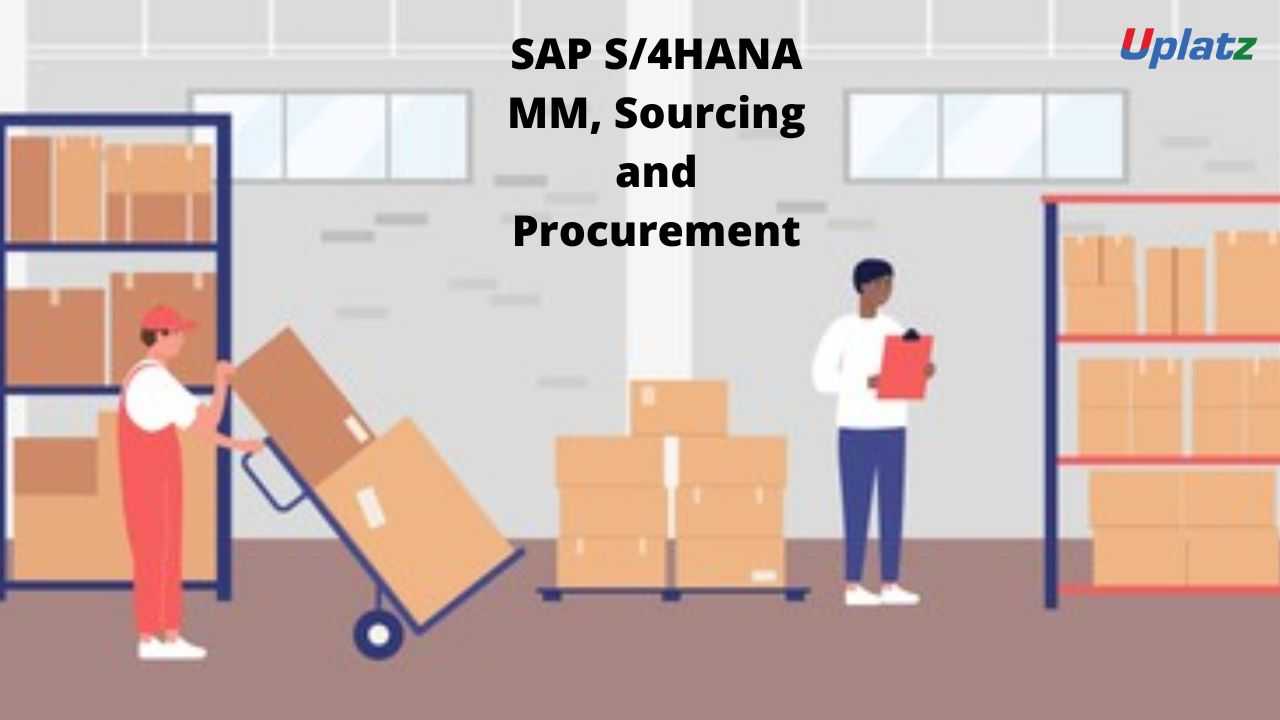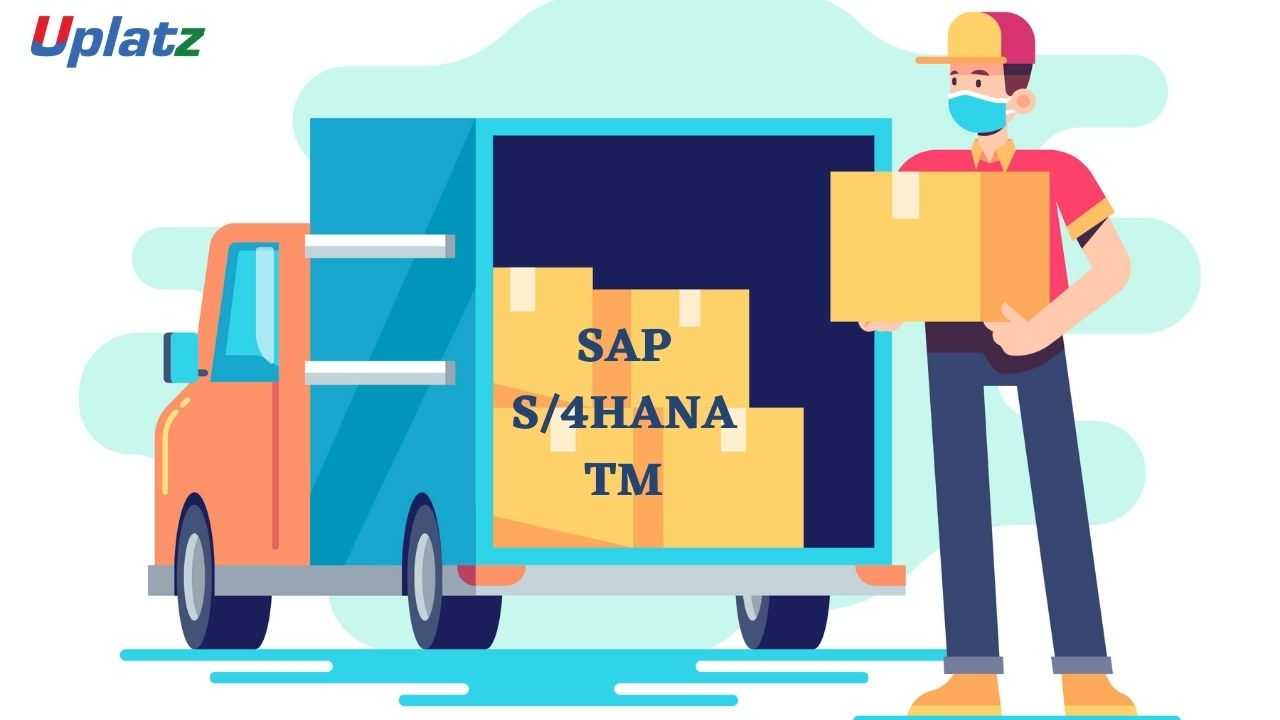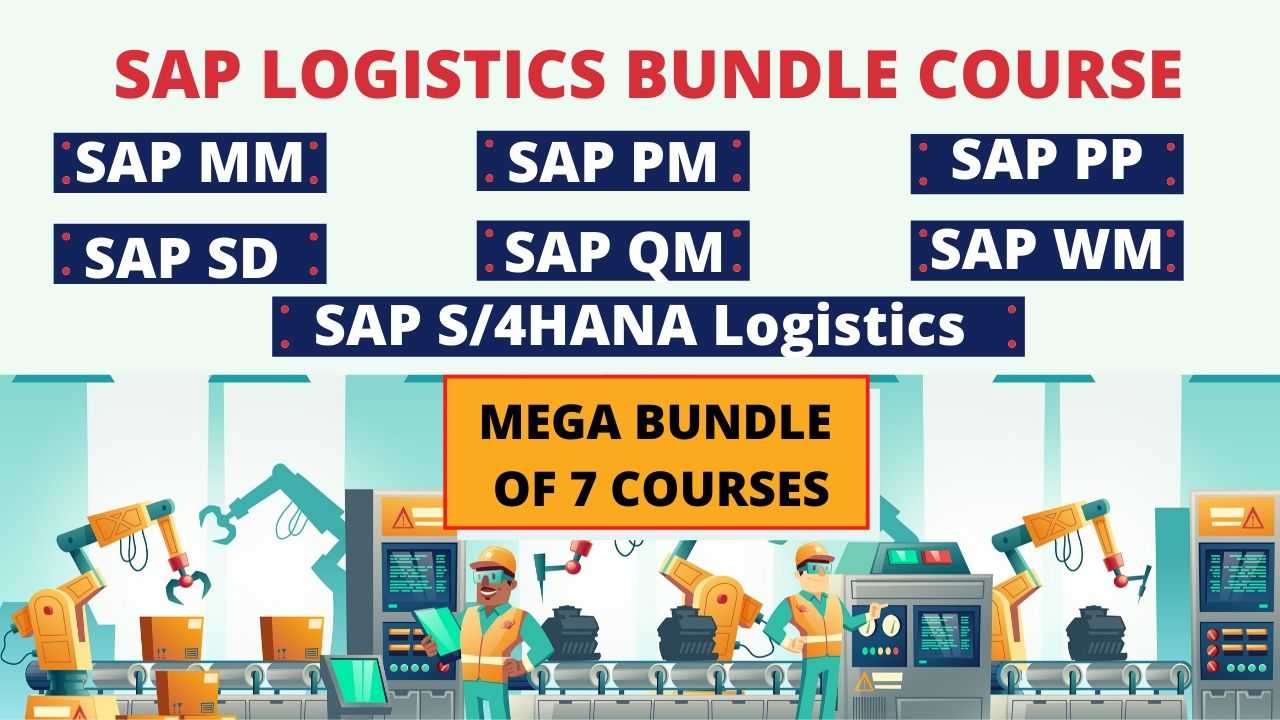SAP S/4HANA EWM 1909
Learn how to monitor the quantity of goods Serial number creation, batch number, supplier inventory, resource optimization and value added services.Preview SAP S/4HANA EWM 1909 course
View Course Curriculum Price Match Guarantee Full Lifetime Access Access on any Device Technical Support Secure Checkout Course Completion Certificate 83% Started a new career
BUY THIS COURSE (
83% Started a new career
BUY THIS COURSE (GBP 12 GBP 29 )-
 80% Got a pay increase and promotion
80% Got a pay increase and promotion
Students also bought -
-

- SAP S/4HANA MM Sourcing and Procurement
- 30 Hours
- GBP 12
- 449 Learners
-

- SAP S/4HANA TM (Transportation Management)
- 25 Hours
- GBP 12
- 533 Learners
-

- Bundle Course - SAP Logistics (PM - PP - MM - QM - WM - SD - S4HANA Logistics)
- 200 Hours
- GBP 22
- 1692 Learners

SAP S/4HANA Extended Warehouse Management (EWM) is used to effectively manage inventory in the warehouse and to support the turnover of goods. This allows the company to control the process of entry and exit in the warehouse and the movement of goods in the warehouse.
The main process in the warehouse consists of incoming and outgoing materials, incoming and outgoing goods, executing customer orders and distributing goods. If the company does not store goods, warehouse management does not have to manage the goods. SAP S/4HANA EWM is an integrated solution within the SAP S/4HANA suite that focuses on optimizing warehouse and inventory management processes. It provides advanced functionalities to manage and control warehouse activities efficiently.
In SAP S/4HANA EWM, all the movement of goods is controlled by the warehouse management system and offers tools to monitor warehouse activity. You can also manage additional functions in the warehouse, eg. B. Serial number creation, batch number, supplier inventory, resource optimization and value added services. With SAP S/4HANA EWM, you can not only monitor the quantity of goods in the warehouse, but also manage other important functions and deliver goods effectively.
Some of the key aspects and features of SAP S/4HANA EWM module are:
1. Unified Platform: SAP S/4HANA EWM is part of the SAP S/4HANA suite, providing a unified platform for managing end-to-end supply chain processes, from procurement to production to distribution.
2. Advanced Warehouse Processes: SAP S/4HANA EWM supports complex warehouse processes, including inbound and outbound processes, internal warehouse movements, cross-docking, wave picking, and value-added services. It enables businesses to streamline and optimize their warehouse operations.
3. Material Flow System Integration: The solution integrates with Material Flow Systems (MFS) to automate and optimize the movement of goods within the warehouse. This includes the integration of conveyor systems, automated storage and retrieval systems (AS/RS), and other automated equipment.
4. Slotting and Replenishment Strategies: SAP S/4HANA EWM provides capabilities for slotting optimization, allowing businesses to strategically place items in the warehouse based on factors such as demand, picking frequency, and storage constraints. Replenishment strategies ensure that stock levels are maintained efficiently.
5. Labor Management: The system includes labor management features to optimize workforce productivity. This includes task interleaving, work center monitoring, and performance analysis to ensure efficient use of labor resources.
6. Integration with Transportation Management: SAP S/4HANA EWM integrates seamlessly with SAP Transportation Management (TM) to coordinate transportation processes with warehouse activities. This ensures a synchronized flow of goods from the warehouse to transportation and eventually to the customer.
7. Real-time Analytics and Reporting: The solution provides real-time analytics and reporting capabilities, allowing users to monitor and analyze key warehouse performance indicators. This visibility helps in making informed decisions and continuously improving warehouse processes.
8. Multi-Client and Multi-Site Capabilities: SAP S/4HANA EWM supports multi-client and multi-site warehouse scenarios, enabling businesses with complex distribution networks to manage multiple warehouses and clients efficiently.
9. Advanced RF (Radio Frequency) Functionality: The system supports advanced RF functionalities, allowing warehouse operators to use mobile devices for tasks such as picking, packing, and inventory management. This improves accuracy and efficiency in warehouse operations.
10. Built-in Integration with SAP Fiori: The solution comes with built-in integration with SAP Fiori, offering a modern and user-friendly interface. This makes it easier for users to interact with the system, perform tasks, and access relevant information.
Implementing SAP S/4HANA EWM can bring significant benefits to organizations by optimizing warehouse processes, improving visibility, and enhancing overall supply chain efficiency. It's important to note that the specifics of the features and functionalities may evolve with updates and new releases of the SAP S/4HANA suite. Organizations considering the implementation of SAP S/4HANA EWM should refer to the latest documentation and consult with SAP experts for the most up-to-date information.
Course/Topic - SAP S/4HANA EWM 1909 - all lectures
-
In this first video on the SAP S/4HANA EWM course, you will get a briefing on the course contents, the objective of the training, and some basic terminologies associated with the Embedded Extended Warehouse Management system.
-
In this video, you will learn about Supply Chain Management starting with a diagrammatic representation of the high-level process of SCM, the definition of EWM, the business functions of EWM, a brief explanation on the De-Centralised EWM, EWM Master Data Distribution, the transaction data flow of De-Centralized EWM, the data transfer process between S4HANA and EWM, Warehouse Layout & many others.
-
This video is a complete practical session on Warehouse Product Maintenance and the complete work process of it will be shown by the trainer in the SAP system.
-
In this video, you will learn about the different terminologies associated with SAP Warehouse Management, whether be it the S/4HANA or EWM. Along with this, you will also learn about the different reasons for deploying Embedded EWM in SAP S/4HANA 1909 instead of Decentralized SCM EWM. Furthermore, you will also learn about the mapping process of S/4HANA Document Type to EWM Document Type.
-
In this video, you will learn about the different processes associated with the Extended Warehouse Management starting with an overview on the Inbound Process; its roles and the process flow, the Outbound Process, the 5 specific warehouse areas, WM Complex Processes, U Flow Layout Design, Slotting & Rearrangement, the difference between WM and S/4HANA EWM and many more.
-
In this session, you will learn about the Slotting & Rearrangement process in S/4HANA Embedded EWM along with the Internal Warehouse Process, Transfer Posting in EWM, Goods Receipt Process in EWM, S/4HANA EWM Master Data, and others.
-
In this video, you will learn about the different stock removal strategies such as FIFO, Stringent FIFO, LIFO, Partial Quantities & others with a detailed explanation of each of them. You will also learn about the complete work process of Storage Control.
-
This is a complete practical session on how to work on the process of Purchase Order and maintaining the Inbound Delivery in the SAP system. The trainer will be showing a step-by-step process of the complete procedure in the SAP system.
-
In this session, you will learn the configuration steps involved in the storage control of POSC with a detailed work process of it being shown in the SAP system.
-
This session will teach you on the work process of Document Flow and other in case of Storage Control in the SAP system.
-
In this video, you will learn about the Process-Oriented Storage Control in Inbound Process with an example and a diagrammatic explanation along with the Material Flow System which will be shown by the trainer in the SAP system.
-
The first part of this video is a revision of the previous sessions being held on various topics. The latter half of the session is for the Activities to be done in EWM like defining availability group, defining non-location-dependent stock type, configuration stock type, and assigning availability group to storage type. All these 4 activities will be shown by the trainer in the SAP system.
-
In this session, you will get practical lessons on the Packaging work procedure for the SAP Extended Warehouse Management system.
-
In this video, you will learn about the Post Processing Framework, commonly abbreviated as PPF, and the configuration of the Work Center in the SAP system.
-
This is the second part of the Post Processing Framework video where you will get some theoretical concepts on PPF like understanding the concept of PPF, the structure of Post Processing Framework, how PPF is used in connection with delivery processing in EWM, the configuration steps for connecting PPF to delivery processing and others.
-
This video is a practical session on Product Description and Wave Management where you will learn the complete work process in the SAP system. The trainer will be showing each and every step in the SAP system.
-
In this video, the trainer will be showing the work procedure of the physical inventory system along with the other tasks associated with it in the SAP system.
-
In this video, you will learn the Inbound and Outbound Processing associated with SAP S/4HANA EWM and its work process in the system.
-
This is a practical session where you will learn and implement the concept of the Putaway Control Indicator in the SAP system.
-
In this video, you will learn about the work procedure of Inbound Delivery associated with the Warehouse Management in the SAP system.
-
This video is a refresh session summary on the topics and agenda already covered throughout the whole course.
-
In this video, you will get a brief overview of the Warehouse Management Complex Processes along with the Warehouse Material U Flow Layout Design, High-Level Process of Supply Chain Management, and the Process Flow in SCM.
-
In this video, you will get a detailed explanation of the SAP EWM Organizational Structure, the terminologies related to the Org Structure such as Warehouse Number, Storage Type, Storage Section, Storage Bin, and Quant.
-
In this last video of the SAP S/4HANA course, you will learn about the maintenance procedure of SCM in the SAP system along with a detailed explanation on Master Data which will be shown with a detailed step-by-step procedure in the SAP system.
The course objectives of this SAP S/4HANA EWM course by Uplatz are:
1) Know what can be done with S/4HANA EWM
2) Create the necessary Organizational Units and Master Data for working with S/4HANA EWM
3) Understand the differences between S/4 HANA EWM and SAP WM
4) Build and execute multiple end-to-end EWM scenarios
5) Understand key functionalities in EWM
6) Know how to create complex inbound and outbound scenarios in the system
7) Learn execution of SAP EWM processes using Fiori in S/4 HANA Embedded EWM - 1909
8) Understand and learn application of SAP Best Practices / Model Company processes in Warehouse Management
9) Understand the core concepts of Warehousing processes in Supply chain management
10) Learn about the Business Partners and its linkage with Customer and Vendor Master
1. SAP Introduction
- Overview of SAP R/3
- Overview of SAP ECC
- Overview of SAP SCM
- Overview SAP S/4 HANA
- Comparison of SAP R/3, SAP ECC, and SAP S/4 HANA
- SAP ECC & SAP S/4 HANA system landscapes, deployments and databases
- Delta Changes & new features
2. Introduction to SAP HANA
- SAP In-Memory Strategy
- Architecture Overview
- Row Store
- Column Store
- Attribute Views
- Calculation Views
3. Introduction to SAP S/4 HANA
- S/4HANA Roadmap
- Benefits of S/4 HANA from business perspective
- Ways from Business Suite to S/4 HANA
- Deployment Options (On Premise, Cloud and Hybrid)
4. Introduction to SAP Activate Methodology
- System conversion
- Landscape transformation
- New Implementation
5. Overview of SAP HANA Cloud Solutions
- SAP Strategy for Cloud and SAP HANA
- SAP Cloud Data Centers
- SAP HANA Enterprise Cloud
- SAP HANA Enterprise Cloud Use Cases
- Examples of On-Premise to Cloud Integration
6. Key Innovations
- Business Partner
- Order Management Billing
- Credit Management
- Inventory Management
- Material Requirement Planning
- Architectural Changes / Configurations related to Sales
7. Overview of Fiori Apps
- Overview of SAP Fiori Apps related to Logistics / Supply Chain
8. SAP S/4 HANA Deployment Options in EWM
- Organizational Units in EWM in S/4
- EWM Landscape.Existing & New
- Planned EWM Road Map for S/4HANA
- Embedded EWM.Business Benefits
9. Master Data in S/4 HANA System
- Master Data creation
- Core Interface (CIF) existing and New
10. Integration in S/4HANA System
- Basic ERP and EWM Integration
- Delivery Document Integration
11. Structural Elements and Master Data in S/4HANA System
- EWM Structural Elements
- EWM Master Data
12. Radio Frequency (RF) Frame Work
- How to use RF Framework
- Developing new screens in RF
- Layout Oriented Storage Control
- ITS Mobile and how to create templates for different mobile devices
13. Goods Receipt and Inbound Process
- Goods Receipt Process Overview
- Goods Receipt using EWM
- ERP and EWM documents
- Availability Groups for Inventory Management
- Goods Receipt Process Overview
- Put-away Rules & Strategies
- Process Oriented Storage Control
- Packing HU management Pack Specification
- Deconsolidation
- Value Added Services (VAS)
- Counting in EWM
14. Goods Issue and Outbound Process
- Goods Issue Process
- Outbound Delivery Processing
- EWM Documents
- Storage Control in Outbound Processing
- Stock / Storage Removal Strategies
- Pick Denial / Handling Differences in Picking
- Batch Management
- Using Pack Specification Condition records management
- Wave processing
- Replenishment
15. Storage Control
- Storage Control Concepts
- Process-Oriented Storage Control
- Layout-Oriented Storage Control
16. Warehouse Order Creation
- Warehouse Order Creation
17. Posting Changes, Stock Transfers and Replenishment
- Posting Changes and Stock Transfers
- Ad-Hoc Movements and Replenishment
18. Physical Inventory
- The Physical Inventory Process
- EWM Physical Inventory Procedures
19. Slotting and Rearrangement
- Slotting and Rearrangement
20. Post Processing Framework (PPF)
- Overview of Post Processing Framework (PPF)
- PPF in Delivery Processing
- Process & Layout Oriented SC
- PPF & Printing Conditions Records in EWM
21. Yard Management
- Introduction to Yard Management and Usage
22. Serial Management in SAP EWM System
- Inventory Level
- Bin Level
- Warehouse Level
23. Cross Docking in SAP EWM System
- Opportunistic Cross Docking
- Transportation Cross Docking
24. Kitting in SAP EWM System
- Kit to order
- Kit to stock
- Reverse Kitting
25. SAP EWM integration with other modules
- Integration of EWM with MM (IM)
- Integration of EWM with PP
- Integration of EWM with SD
- Integration of EWM with TM
26. SAP S/4 HANA – Interfaces
- SAP to SAP Interface
- SAP to non-SAP Interface
The SAP S/4HANA EWM 1909 Certification ensures you know planning, production and measurement techniques needed to stand out from the competition.
SAP EWM is the NEW functionality that SAP provides for the management of inventory in different specific locations inside the new release S/4 HANA. Although not needed in all organizations, it is a module every logistics consultant or practitioner should know about.
SAP Extended Warehouse Management (EWM) is used to efficiently manage inventory in the Warehouse and for supporting the processing of goods movement. It allows the company to control its Warehouse inbound and outbound processes and movement of goods in the Warehouse.
EWM Release 9.4 has been available since 12.05. 2016 and contains some important innovations: Supply Chain ExecutionThere are a total of three innovations on the Supply Chain Execution Platform, i.e. the interaction of Extended Warehouse Management and Transportation Management.
Uplatz online training guarantees the participants to successfully go through the SAP S/4HANA EWM 1909 Certification provided by Uplatz. Uplatz provides appropriate teaching and expertise training to equip the participants for implementing the learnt concepts in an organization.
Course Completion Certificate will be awarded by Uplatz upon successful completion of the SAP S/4HANA EWM 1909 online course.
The SAP S/4HANA EWM 1909 draws an average salary of $119,000 per year depending on their knowledge and hands-on experience.
SAP EWM is used to efficiently manage inventory in a warehouse and to support the processing of inventory movements. It allows any company to control the incoming and outgoing processes of its warehouse and the movement of goods in the warehouse.
In Supply Chain Management which is the rational measure of logistical activities of the final items, EWM has been made as one of the finest of SAP's programs. From 2007 onwards, this has been provided to so many small and large size companies.
Note that salaries are generally higher at large companies rather than small ones. Your salary will also differ based on the market you work in.
SAP Security Specialist.
SAP Logistics Execution.
Manager, IT Operations.
SAP SCM/EWM Consulting Manager.









